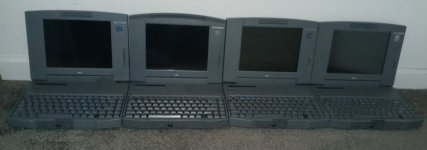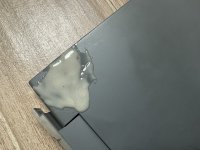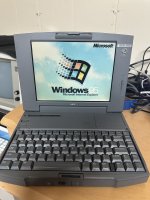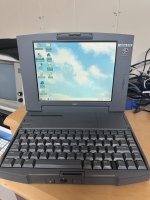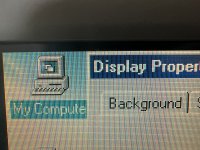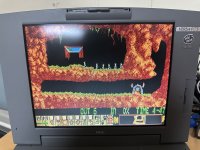creepingnet
Veteran Member
In 1993, NEC continued their "Ultralite" series with a brand new string of 486 (and eventually a Pentium) model(s) of laptop all sharing the same basic platform - the NEC Ultralite Versa, which would be the 3rd generation Ultratlie, and the 1st laptop of theirs to be marketed with the "Versa" model name. These models started with the NEC Ultralite Versa in 1993, and ended with the end of production of the Versa P/75 in 1996.
The reason, I presume, for the name addition of "Versa" was because these laptops were among some of the first user-upgradable laptops via various modules. The hard drives came in "Versa Paks" designed to be easily swapped from under snap-on covers, the memory came in what appears to be a quasi-PCMCIA Type I format in the form of 3.3V Memory cards in capacities of 4MB, 8MB, 16MB, or 32MB. They all also featured a Floppy drive that could be removed to make room for an extra internal battery for more battery life, and most notably - the screen was user upgradable as well, being offered in several variants over the course of the platform's lifecycle including high resolution models and models with touch screens - effectively making these among the first "convertibles" on the PC market a full 20 years before Windows 8 inspired OEM's to make detachable screen convertible laptops such as the Lenovo Yoga, Microsoft Surface, or Dell XPS 12.
Now onto the specific models....
NEC Ultralite Versa (1993-1994)
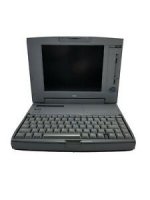
SPECIFICATIONS
PSU: Large "Brick" PSU of 13.4V w/ 4 pin connector
BAT: 7.2V DC 3800maH Nickel Metal Hydride (NiMH) Battery (no Logic), up to 2 (with Floppy removed)
CPU: Intel 486 DX SL in 3 clock speeds, 20MHz (PC-400), 25MHz (PC-410), or 33MHz (PC-420)
RAM: 4MB on-board, expandable to 20MB via Memory Cards
FDD: 1.44MB 3.5" Floppy Drive
HDD: 80MB, 120MB, or 250MB IDE "Versa Paks"
GFX: Western Digital WDC0924 1MB SVGA Graphics Chipset and LCD Controller
LCDS: 9.4" Active Matrix TFT or 9.4" DTSN Dual Scan Monochrome, with or without Touch (Dec 1993+)
SRP: $2500-6000 Depending on configuration
In 1993 NEC released the third generation Ultralite, the "Ultralite Versa", as the first i486 based laptop/notebook computer they had on the market. They retained the Ultralite name most likely because it still weighed under 8LBS although by this point it was pretty comparable to everyone else's laptop in size and weight, and it had been that way since the Ultralite SL Series that predates the Versa. The name "Versa" was likely added due to the "Vers"itility of the machine, being able to be user upgraded or downgraded all the way from a base level monochrome machine with 4MB of RAM and a 80MB HDD, all the way to a full featured convertible tablet with a 33MHz CPU, 20MB of RAM, a 250MB HDD, and Windows (3.1) for Pen Computing installed - among the first ever portable PC convertible tablets to market.
Initially the 20 and 25MHz models were the only ones available, with a 33MHz being introduced sometime in late 1993. Initial offerings for screens were initially just the 9.4" Monochrome DTSN Kyocera panel, and a 9.4" Active Matrix TFT NEC NL6448AC30-03 hosting vibrant, rich colors, very comfortable brightness, and very clean text with no ghosting, putting it above most 486 laptops on the market at the time. In a current context, using a Versa with the color screen is not much unlike using a modern laptop screen. Later 3M's MicroTouch Division teamed up with NEC to add touch to both panels, this would be sometime around early-mid 94' as even the later E-series does not list it as an official option - but rather relegated most of it's promotion by that point to a phone number you could call in the user-guide to order this feature. It also was praised by PC Magazine for it's graphics performance which "ran circles around the competition".
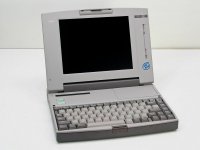
1993 NCR (AT&T) Safari 3180 in Monochrome
National Cash Register (NCR) also contracted out NEC to make their higher end laptops for them around this time, in this case, the NCR Safari 3180, which is almost identical to the NEC Ultralite Versa in every way, save for the name, it only came in 33MHz, and had different case coloring - with the keyboard bezel and screen bezel being a brighter gray, and "surf green" molded standby and power buttons, and Fn Key lettering on the keyboard keys in the same color.
Both versions boasted up to 8 hours of battery life using 2 batteries. It's been speculated numerous times in magazine polls from the time that NEC Was Exaggerating these numbers. In my own real-world experience, 3 hours might be possible with extreme power management, but a more realistic estimate would be around 2 hours, which for 1993 is quite good.
However, the originals did have some complaints. The main two being the power supply was huge, the size of a literal brick, and the other being a complete lack of a built-in pointing device. Instead NEC's solution was to offer a Microsoft Ballpoint Mouse as a factory option on the Ultralite Versa.
NEC Versa E-Series (1994-1995)
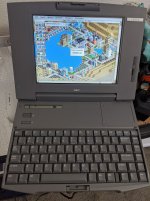
SPECIFICATIONS
PSU: New Smaller Power Brick, about the size of a guitar pedal, 13.4VDC, same 4-pin connector
BAT: 7.2V DC 3800maH Nickel Metal Hydride (NiMH) Battery (no Logic), up to two (with Floppy removed)
CPU: Intel 486 DX 2 SL or DX4 in 3 different clock speeds - 40MHz (PC-440), 50MHz (PC-450), and 75 MHz (PC-460)
RAM: 4MB on-board, expandable to 20MB via Memory Cards
FDD: 1.44MB 3.5" Floppy Drive
HDD: 120MB, 250MB, or 325MB IDE "Versa Paks"
GFX: Western Digital WDC0924 1MB SVGA Graphics Chipset and LCD Controller
LCDS: 9.4" Active Matrix TFT or 9.4" DTSN Dual Scan Monochrome, with or without Touch (Dec 1993+)
SRP: $3000-6500 Depending on configuration
Starting sometime in early 1994, the Versa E-series, likely standing for "Enhanced" was released, including the 40E, 50E, and toward the end of 1994 they added a 75MHz DX4 Model (75E) to the lineup. NEC addressed complaints about the power supply and lack of a pointing device on these models, making the power supply as small as a guitar distortion pedal, and redesigned the motherboard and case to accomodate a new "VersaTrak" Trackball. The "enhanced" likely refers to the clock doubled DX2, and later clock tripled DX4 CPUs utilized, along with the other improvements.
According to the book "ThinkPad - A Different Shade of Blue" - NEC dropped the Ultralite moniker from the Versa at this point as they felt it made the model name too complex for their laptops. This change is also reflected in the badging, as the E-series is the only model with a plain silver badge that just says "Versa" on it and nothing else. I feel this also could have been a change made as the Versa was not so "ultralite" anymore - the original was a 5LB notebook the size of an A4 piece of paper with eight hours of battery life and solid state storage - whereas these were more conventional 7-10LB Laptops with regular 2.5" IDE drives, 2-4 hours of battery life out of the box, and thusly far more conventional, despite the user upgradable configuration or convertible laptop.
The same screen options were offered as the Ultralite, with an improved LCD panel with one backlight - the NL6448AC30-06 - to address power concerns (the NL6448AC30-03 of the original Ultralite had two Cold Cathode backlights).
A common misconception about the Versa E is that a lot of people mistake them as the "Versa V", as likely confused or unknowledgable sales reps and helpdesk techs confused the two as they have the same basic specs, except the V only came with a non-removable screen per the service manual and user guide.
NCR and AT&T had a merger sometime around this time and thusly this model was offered, likely only in 75MHz as the AT&T Safari 3181 model. All the same notes apply as did the 3180 regarding the cosmetics. At least one computer magazine garnered some confusion on whether the AT&T and NEC models were different due to some mistakes during their testing of this version that lead to erronius benchmarks on the NEC making the AT&T look better.
NEC Versa V-Series (1994-1995)

SPECIFICATIONS
PSU: New Smaller Power Brick, about the size of a guitar pedal, 13.4VDC, same 4-pin connector
BAT: 7.2V DC 3800maH Nickel Metal Hydride (NiMH) Battery (no Logic), up to two (with Floppy removed)
CPU: Intel 486 DX 2 SL or DX4 in 3 different clock speeds - 40MHz (PC-440), 50MHz (PC-450), and 75 MHz (PC-460)
RAM: 4MB on-board, expandable to 20MB via Memory Cards
FDD: 1.44MB 3.5" Floppy Drive
HDD: 120MB, 250MB, or 325MB IDE "Versa Paks"
GFX: Western Digital WDC0924 1MB SVGA Graphics Chipset and LCD Controller
LCDS: 9.4" Active Matrix TFT or 9.4" DTSN Dual Scan Color, or 9.4" DTSN Monochrome, all 640x480p
SRP: $1500-4700 Depending on configuration
A little later in 1994, the Versa "V" - likely for "Value" - was released. The V-series were not convertibles like the others in the Versa line, but rather, a standard clamshell laptop based around the platform of the convertibles. They shared almost identical specifications with the Versa E-series and often cause people to confuse the Versa E as being a Versa V model. The only real difference is the screen options are different, no touch was offered, and they had a DTSN Dual Scan color option available for these laptops. Because of the non-detachable screen, the screen was no longer user upgradable. The Versa V seemed to have a longer lifespan, being produced well into mid-1995, likely to use up Versa E-series parts - as it shared the product lineup with the M/75, M/100, and P/75. Likely it was the "budget" model in that lineup.
NEC Versa M-Series (1994-1995)
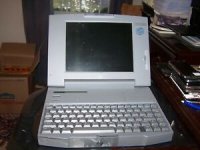
SPECIFICATIONS
PSU: New Smaller Power Brick, about the size of a guitar pedal, 13.4VDC, same 4-pin connector
BAT: 7.2V DC 3800maH Nickel Metal Hydride (NiMH) "Smart Battery", up to two (with floppy removed)
CPU: Intel 486 DX4 in two clock speeds: 75MHz (M/75), and 100MHz (M/100)
RAM: 8MB on-board, expandable to 40MB via Memory Cards
FDD: 1.44MB 3.5" Floppy Drive
HDD: 250MB, 320MB, 540MB, and 810MB HDD
GFX: C&T 65545 Graphics Chipset and LCD Controller w/ one of two LCD Modules
LCDS: 9.4", maybe later 10.4" Active Matrix Displays in color only, offering True Color (TC) and 800x600 (HC) options
TOUCH?: It seems they were still unofficially offering touch on these models at this point
SRP: $3000-6500 Depending on configuration
In mid 1994 the Versa "M" Series (Multimedia) were released. These were DX4 based laptop computers with a Crystal CS-4231-KQ "Business Audio" (Windows Sound System compatible (WSS 2.0)) chipset with no OPL synth on board. These were also the first models to offer 800x600 "High Resolution" panels and a "true Color" screen option.
The TC Models caused a split into 4 actual models of this line: the M/75 and M/100 PC-4xx models used a different graphics controller chip from the M/75 and M/100 PC-5xx models which featured a new NEC NL6448AC30-09 industrial display panel, requiring a new specialized and thicker housing, and a special daughtercard, as well to drive the 24-bit color LCD. The 470 and 480 models featured a Hi-Top LCD controller chipset that could utilize all the original panels going back to the original Ultralite Versa - including the brand new 800x600 LCD Panel the HC models used.
Other changes included a brand new Floppy Disk caddy design due to changes to the power section of the motherboard, and new "Smart Batteries" designed to improve power management, battery life, and performance by adding a small logic board and 2 more connectors to the battery. These batteries only work in the Versa M and Versa P models - however I have seen that the older batteries work in the M and P series computers as well.
Also, to accomodate the new Multimedia features, a small grid over the mono speaker on the laptop and a pinhole about 1.5" away for the microphone were added. The WSS compatible audio boasted a full 44.1KHz 16-bit CD Quality Audio, but was crippled for games and MiDi by the lack of a proper Yamaha OPL synth to go with the 4231 chip.
NEC Versa P-Series (1995-1996)

SPECIFICATIONS
PSU: New Smaller Power Brick, about the size of a guitar pedal, 13.4VDC, same 4-pin connector
BAT: 7.2V DC 3800maH Nickel Metal Hydride (NiMH) "Smart Battery", up to two (with floppy removed)
CPU: Intel Pentium 75Mhz
RAM: 8MB on-board, expandable to 40MB via Memory Cards
FDD: 1.44MB 3.5" Floppy Drive
HDD: 250MB, 320MB, 540MB, and 810MB HDD
GFX: C&T 65545 Graphics Chipset and LCD Controller w/ one of two LCD Modules
LCDS: 9.4", maybe later 10.4" Active Matrix Displays in color only, offering True Color (TC) and 800x600 (HC) options
SRP: $1500-4500 Depending on configuration
By this time the platform had started to age, so this was NEC's last hurrah before introducing the 2000/4000/6000 series laptops a year later. The P/75 boasted a "major" performance increase over the 486 based M-series, and had a massive improvement in sound with the inclusion of an ESS688S AudioDrive SoundBlaster Compatible chipset with OPL3 as standard equipment. Other than that, and some small cosmetic differences, it was pretty much the same system as the M/75 was - it was Bus "crippled" by still having the same 2x 16-bit PCMCIA Type II slots as all the other models in this series, and still using VESA Local Bus for the graphics subsystem with the same chip as the M/75 - really noticeable when running games that would run better on a Desktop or newer Laptop with a PCI Bus. Magazines critiqued the model as "Showing it's age". Later versions were offered with a assumed 800x600 LCD Panel in 10.5" rather than the original 9.4" display of the original. In 1996 the P/75 was discontinued and replaced with the aforementioned 2000/4000/6000 series laptops.
DOCKING STATIONS
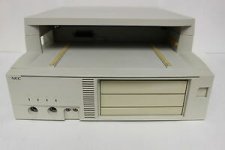
VersaDock - There were two models of VersaDock compatible with these computers - the VersaDock, and VersaDock II - also marketed as the AT&T DS Docking Station for the AT&T models. It was a large enclosure roughly the size of a regular LPX Desktop of the time, where the Versa would slide into a slot, and a monitor could be set on a stand above the laptop. It featured VGA, Serial, and LPT ports, 2x 16-bit ISA Slots, one quarter height and one half height 5.25" drive bays for adding extra data storage options, a mounting plate inside for installing an extra hard disk for more storage, and mic and headphone jacks for the soundcard equipped M/P models (The Ultralite, E, and V models still output from the internal speaker on the laptop). There's also a switch in the back allowing quick switching between using the dock's internal floppy drives, or the floppy on the laptop, as the primary floppy drive. Also, the BIOS has to store a second configuration for Docked, and the Docking function is not hot-swappable - docking the Versa while on will not pass control to the keyboard and mouse attached to the dock, but rather, prevent you from using it unless you reboot.
https://i.ebayimg.com/images/g/PHcAA...D3/s-l1600.jpg - Will link when I can download and edit later
MediaDock - Sometime in 1994 or 1995, NEC introduced a "MediaDock", likely as a solution for complaints about the lack of SoundBlaster compatible Audio on the Versa M. The Media Dock features 2 built in speakers, an ESS688 SoundBlaster Compatible Audio system, a 2x Speed CD-ROM Drive (IDE), and all the appropriate ports. The idea was to improve multimedia support for presentations. It's quite an odd option that's kind of rare.
Last edited:

